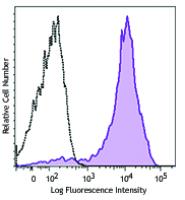-
Sign In
-

-
 Sony Biotechnology
Sony Biotechnology
-

-
 Sony Biotechnology
Sony Biotechnology
Brilliant Violet 605™ anti-human CD49d
Antibodies Single
Sony
9F10
Flow Cytometry
Mouse IgG1, κ
Human
2121615
$226.00
Description
CD49d is a 150 kD α integrin chain known as α4 integrin or VLA-4 α chain. It forms a heterodimer with either integrin β1 (α4β1, VLA-4) or β7 (α4β7). CD49d is expressed broadly on T lymphocytes, B lymphocytes, monocytes, thymocytes, eosinophils, basophils, mast cells, NK cells, dendritic cells, and some non-hematopoietic cells, but not on normal red blood cells, platelets or neutrophils. VLA-4 binds to VCAM-1 (CD106) and fibronectin. α4β7 is the receptor for VCAM-1 and MAdCAM-1. CD49d participates in mononuclear cell trafficking to endothelial sites of inflammation and has roles in cell-cell interactions and cell adhesion to extracellular matrices. CD49d is involved in lymphocyte migration, T cell activation, and hematopoietic stem cell differentiation. CD49d is a marker to isolate pure populations of Treg cells due to its absence on Foxp3+ cells.
Formulation
Phosphate-buffered solution, pH 7.2, containing 0.09% sodium azide and BSA (origin USA).Recommended Usage
Each lot of this antibody is quality control tested by immunofluorescent staining with flow cytometric analysis. For flow cytometric staining, the suggested use of this reagent is ≤5 microL per million cells or 5 microL per 100 microL of whole blood. It is recommended that the reagent be titrated for optimal performance for each application.
Brilliant Violet 605™ excites at 405 nm and emits at 603 nm. The bandpass filter 610/20 nm is recommended for detection, although filter optimization may be required depending on other fluorophores used. Be sure to verify that your cytometer configuration and software setup are appropriate for detecting this channel. Refer to your instrument manual or manufacturer for support. Brilliant Violet 605™ is a trademark of Sirigen Group Ltd.
References
1. Schlossman S, et al. Eds. 1995. Leucocyte Typing V. Oxford University Press. New York.
2. Jeong SH, et al. 2004. J. Virol. 78:6995. (Costim)
3. Vogel TU, et al. 2002. J. Immunol. 169:4511. (Costim)
4. Kleinewietfeld M, et al. 2009. Blood 113:827. (FC) PubMed
5. Palacious F, et al. 2010. Blood 115:4488. PubMed
6. Yoshino N, et al. 2000. Exp. Anim. (Tokyo) 49:97. (FC)
7. Sestak K, et al. 2007. Vet. Immunol. Immunopathol. 119:21.
8. Mattapallil MJ, et al. 2011. J. Immunol. 187:1977. PubMed


